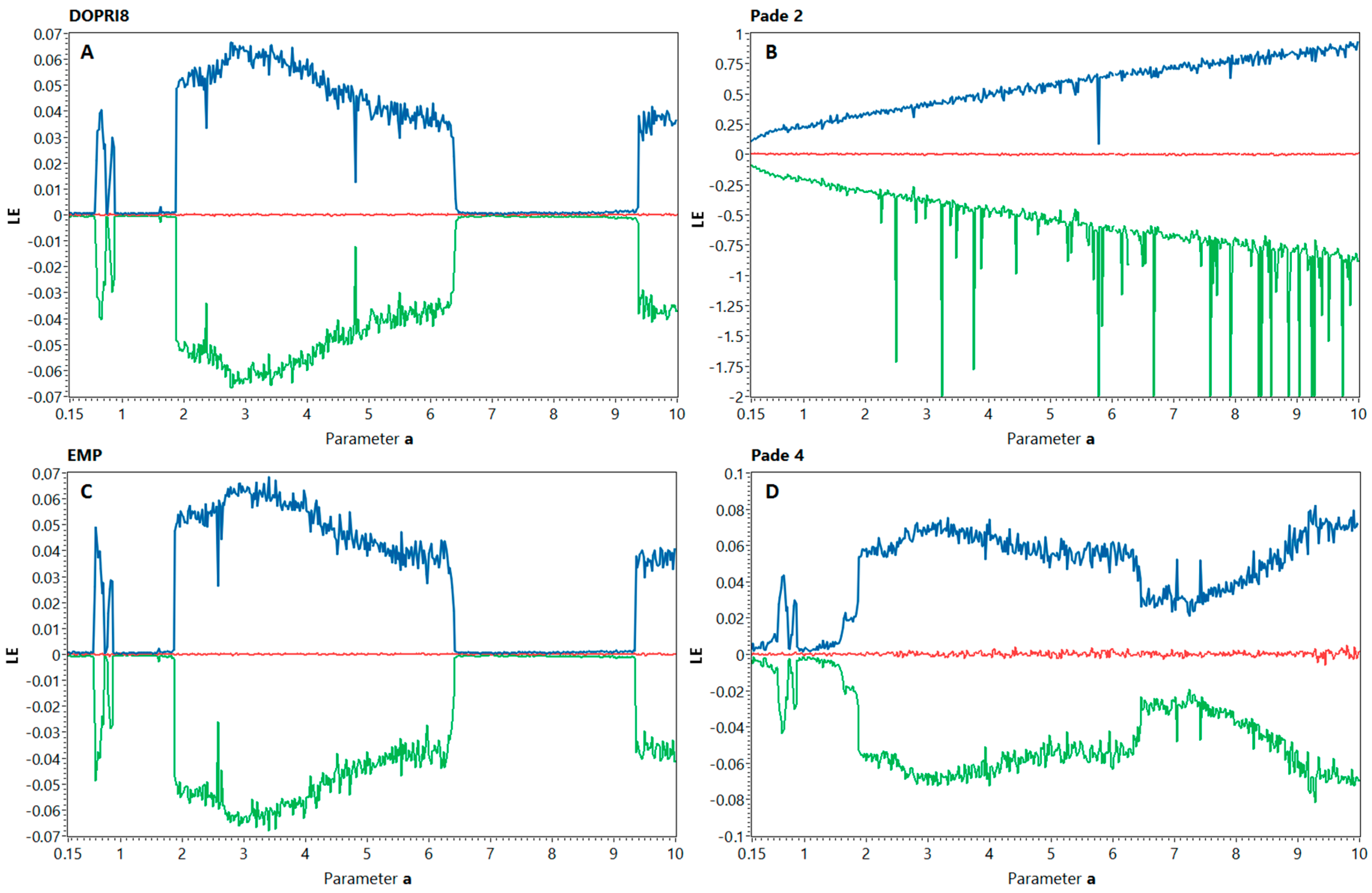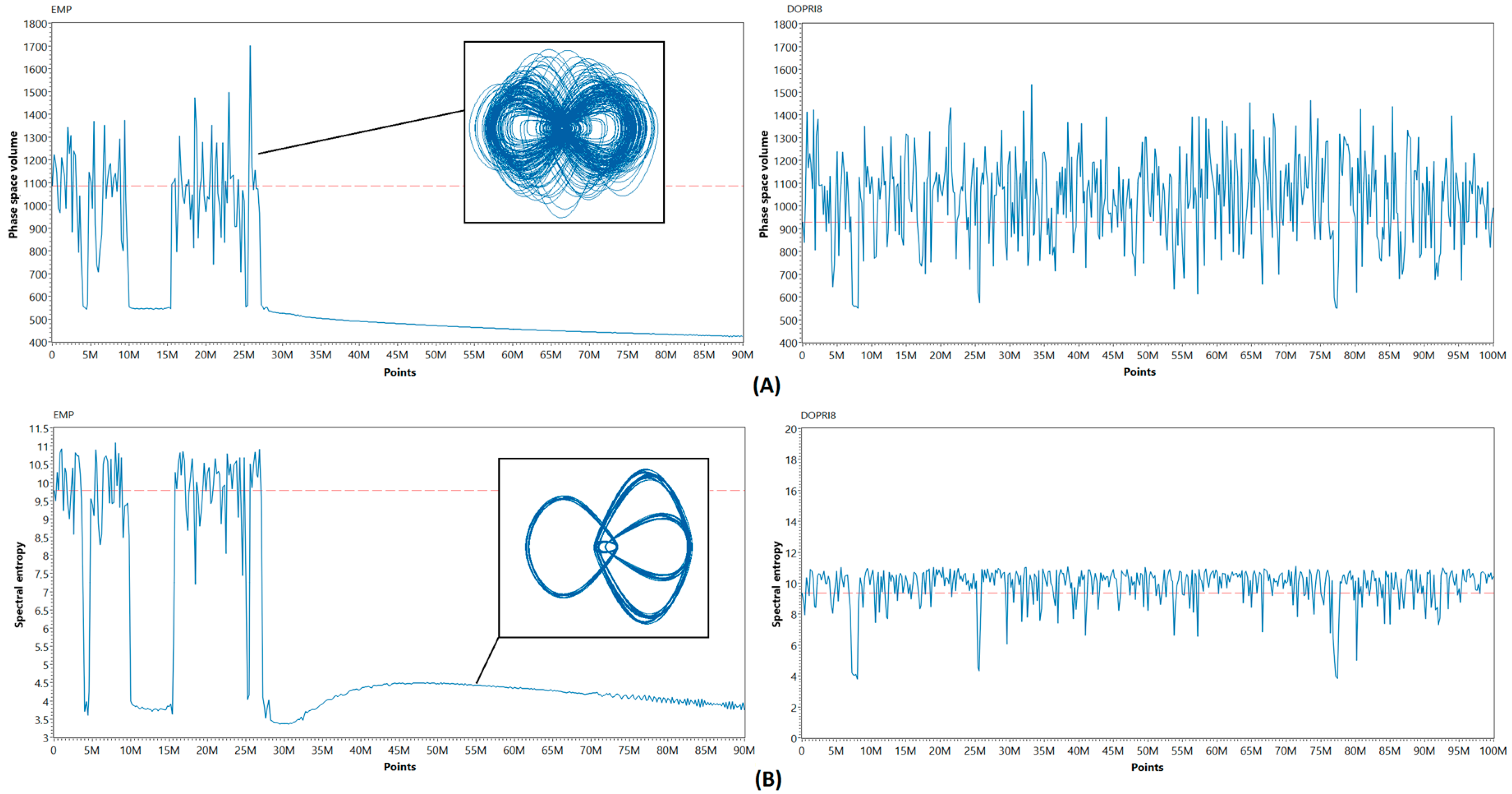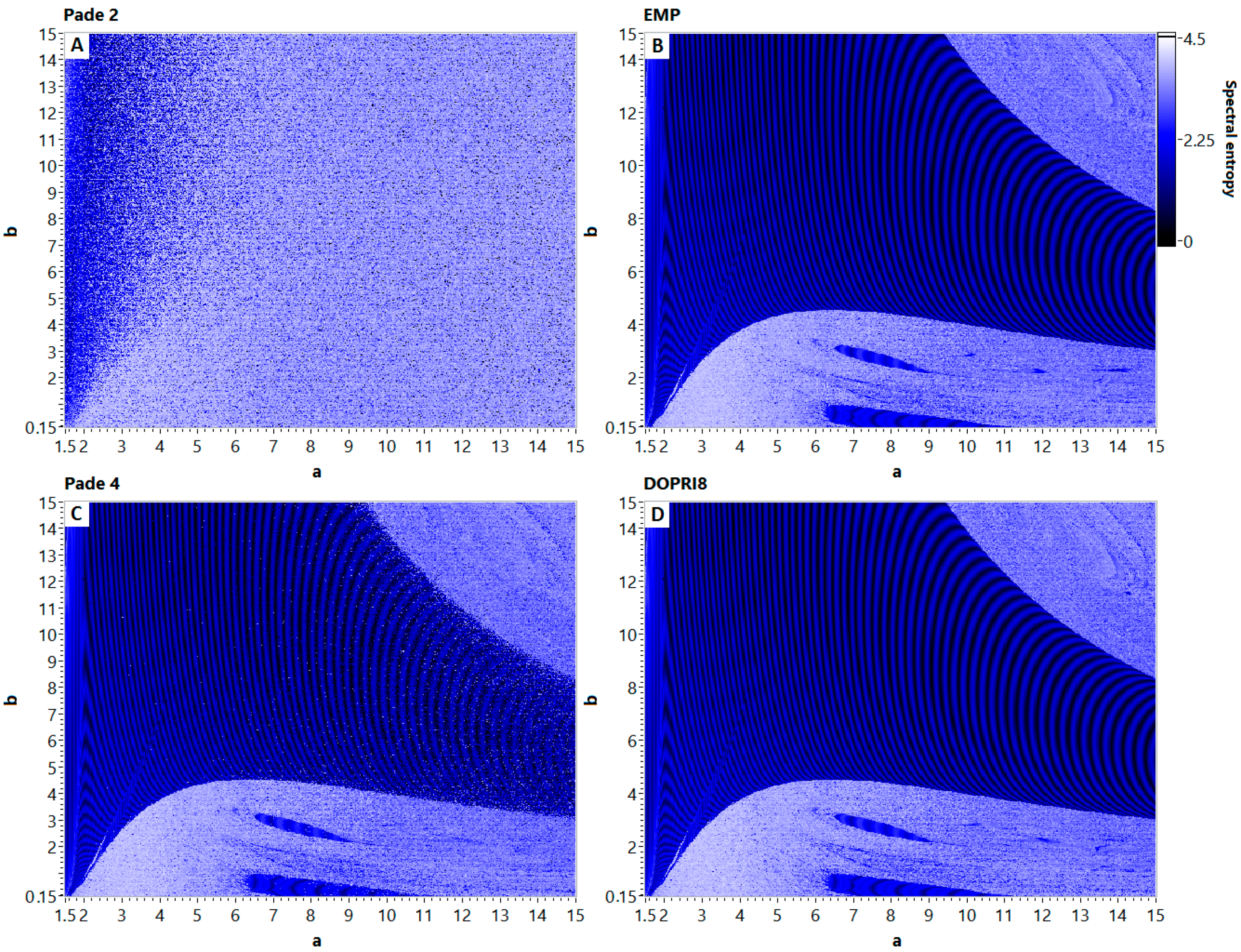The Effects of Padé Numerical Integration in Simulation of Conservative Chaotic Systems
Abstract
:1. Introduction
2. Materials and Methods
2.1. Integration Methods Based on Padé Approximants
2.2. Hypothesis
3. Results
3.1. Bifurcation, Lyapunov Spectrum, and Spectral Entropy Analysis
3.2. Long-term Simulation and Phase Volume Dynamics
3.3. Dynamical maps
4. Conclusions & Discussion
Author Contributions
Funding
Conflicts of Interest
References
- Lozi, R.; Pchelintsev, A.N. A new reliable numerical method for computing chaotic solutions of dynamical systems: The Chen attractor case. Int. J. Bifurc. Chaos 2015, 25, 1550187. [Google Scholar] [CrossRef]
- Lozi, R.; Pogonin, V.A.; Pchelintsev, A.N. A new accurate numerical method of approximation of chaotic solutions of dynamical model equations with quadratic nonlinearities. Chaos Solitons Fract. 2016, 91, 108–114. [Google Scholar] [CrossRef]
- Corless, R.M.; Essex, C.; Nerenberg, M.A.H. Numerical methods can suppress chaos. Phys. Lett. A 1991, 157, 27–36. [Google Scholar] [CrossRef]
- Lozi, R. Can we trust in numerical computations of chaotic solutions of dynamical systems? In Topology and Dynamics of Chaos; Letellier, C., Gilmore, R., Eds.; World Scientific: Hackensack, NJ, USA, 2013; Volume 84, pp. 63–98. [Google Scholar] [CrossRef]
- Nepomuceno, E.G.; Mendes, E.M. On the analysis of pseudo-orbits of continuous chaotic nonlinear systems simulated using discretization schemes in a digital computer. Chaos Solitons Fract. 2017, 95, 21–32. [Google Scholar] [CrossRef]
- Wanner, G.; Hairer, E.; Nørsett, S.P. Order stars and stability theorems. BIT Numer. Math. 1978, 18, 475–489. [Google Scholar] [CrossRef]
- Alaybeyi, M. On the Relationship between Integration and Padé Approximation. Ph.D. Thesis, Carnegie Mellon University, Pittsburgh, PA, USA, 1994. [Google Scholar]
- Brezinski, C.; Van Iseghem, J. Padé approximations. In Handbook of Numerical Analysis; Elsevier: Amsterdam, The Netherlands, 1994; Volume 3, pp. 47–222. [Google Scholar]
- Wuytack, L. Numerical integration by using nonlinear techniques. J. Comput. Appl. Math. 1975, 1, 267–272. [Google Scholar] [CrossRef]
- Werner, H.; Wuytack, L. Nonlinear quadrature rules in the presence of a singularity. Comput. Math. Appl. 1978, 4, 237–245. [Google Scholar] [CrossRef]
- Ramos, H. A non-standard explicit integration scheme for initial-value problems. Appl. Math. Comput. 2007, 189, 710–718. [Google Scholar] [CrossRef]
- Gadella, M.; Lara, L.P. A Numerical method for solving ODE by rational approximation. Appl. Math. Sci. 2013, 7, 1119–1130. [Google Scholar] [CrossRef]
- Ramos, H.; Singh, G.; Kanwar, V.; Bhatia, S. An embedded 3 (2) pair of nonlinear methods for solving first order initial-value ordinary differential systems. Numer. Algorithms 2017, 75, 509–529. [Google Scholar] [CrossRef]
- Karimov, T.I.; Butusov, D.N.; Pesterev, D.O.; Predtechenskii, D.V.; Tedoradze, R.S. Quasi-chaotic mode detection and prevention in digital chaos generators. In Proceedings of the IEEE Conference of Russian Young Researchers in Electrical and Electronic Engineering (ElConRus), Saint-Petersburg, Russia, 2018; pp. 319–323. [Google Scholar] [CrossRef]
- Liao, S.J.; Wang, P.F. On the mathematically reliable long-term simulation of chaotic solutions of Lorenz equation in the interval [0,10000]. Sci. China Phys. Mech. 2014, 57, 330–335. [Google Scholar] [CrossRef]
- Grazier, K.R.; Newman, W.I.; Hyman, J.M.; Sharp, P.W.; Goldstein, D.J. Achieving Brouwer’s law with high-order Stormer multistep methods. ANZIAM J. 2005, 46, 786–804. [Google Scholar] [CrossRef]
- Jafari, S.; Sprott, J.C.; Dehghan, S. Categories of conservative flows. Int. J. Bifurc. Chaos 2019, 29, 1950021. [Google Scholar] [CrossRef]
- Huynh, V.V.; Ouannas, A.; Wang, X.; Pham, V.-T.; Nguyen, X.Q.; Alsaadi, F.E. Chaotic map with no fixed points: entropy, implementation and control. Entropy 2019, 21, 279. [Google Scholar] [CrossRef]
- Nosé, S. A molecular dynamics method for simulations in the canonical ensemble. Mol. Phys. 1984, 52, 255–268. [Google Scholar] [CrossRef]
- Hoover, W.G. Canonical dynamics: equilibrium phase-space distributions. Phys. Rev. A 1985, 31, 1695. [Google Scholar] [CrossRef]
- Pham, VT.; Volos, C.; Kapitaniak, T. Systems without equilibrium. In Systems with Hidden Attractors; Springer: Cham, Switzerland, 2017; pp. 51–63. [Google Scholar] [CrossRef]
- Hairer, E.; Norsett, S.P.; Wanner, G. Solving Ordinary Differential Equations I: Nonstiff Problems; Springer: Berlin, Germany, 1993. [Google Scholar]
- Wolf, A.; Swift, J.B.; Swinney, H.L.; Vastano, J.A. Determining Lyapunov exponents from a time series. Physica D 1985, 16, 285–317. [Google Scholar] [CrossRef]
- Crepeau, J.; Lavar, K.I. On the spectral entropy behavior of self-organizing processes. J. Non-Equilib. Thermodyn. 1990, 15, 115–126. [Google Scholar] [CrossRef]
- Pyko, N.S.; Pyko, S.A.; Markelov, O.A.; Karimov, A.I.; Butusov, D.N.; Zolotukhin, Y.V.; Uljanitski, Y.D.; Bogachev, M.I. Assessment of cooperativity in complex systems with non-periodical dynamics: Comparison of five mutual information metrics. Physica A 2018, 503, 1054–1072. [Google Scholar] [CrossRef]
- Tsai, C.; Wang, H.; Wu, J. Three techniques for enhancing chaos-based joint compression and encryption schemes. Entropy 2019, 21, 40. [Google Scholar] [CrossRef]
- Kaya, D.; Ergun, S. An analysis of deterministic chaos as an entropy source for random number generators. Entropy 2018, 20, 957. [Google Scholar] [CrossRef]
- Alvarez, G.; LI, S. Some basic cryptographic requirements for chaos-based cryptosystems. Int. J. Bifurc. Chaos 2006, 16, 2129–2151. [Google Scholar] [CrossRef]







| Accuracy Order | Numerator | Denominator |
|---|---|---|
| 1 | ||
| 2 | ||
| 3 | ||
| 4 | ||
| 5 | ||
| 6 |
© 2019 by the authors. Licensee MDPI, Basel, Switzerland. This article is an open access article distributed under the terms and conditions of the Creative Commons Attribution (CC BY) license (http://creativecommons.org/licenses/by/4.0/).
Share and Cite
Butusov, D.; Karimov, A.; Tutueva, A.; Kaplun, D.; Nepomuceno, E.G. The Effects of Padé Numerical Integration in Simulation of Conservative Chaotic Systems. Entropy 2019, 21, 362. https://doi.org/10.3390/e21040362
Butusov D, Karimov A, Tutueva A, Kaplun D, Nepomuceno EG. The Effects of Padé Numerical Integration in Simulation of Conservative Chaotic Systems. Entropy. 2019; 21(4):362. https://doi.org/10.3390/e21040362
Chicago/Turabian StyleButusov, Denis, Artur Karimov, Aleksandra Tutueva, Dmitry Kaplun, and Erivelton G. Nepomuceno. 2019. "The Effects of Padé Numerical Integration in Simulation of Conservative Chaotic Systems" Entropy 21, no. 4: 362. https://doi.org/10.3390/e21040362
APA StyleButusov, D., Karimov, A., Tutueva, A., Kaplun, D., & Nepomuceno, E. G. (2019). The Effects of Padé Numerical Integration in Simulation of Conservative Chaotic Systems. Entropy, 21(4), 362. https://doi.org/10.3390/e21040362









